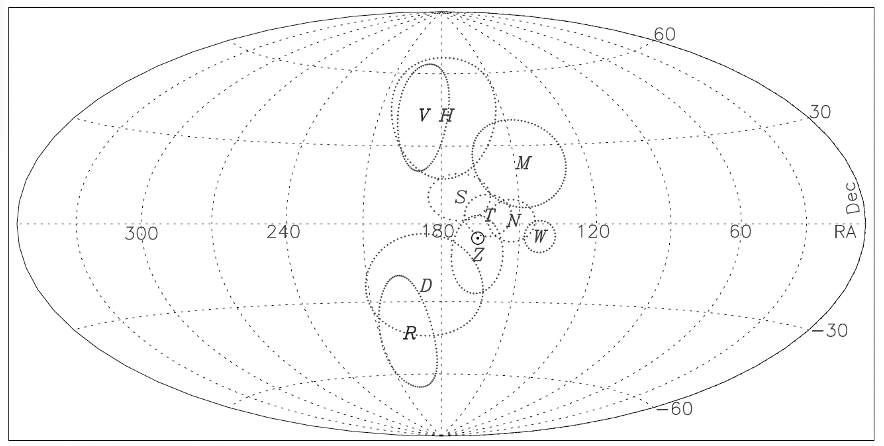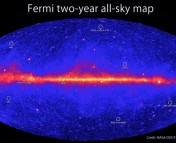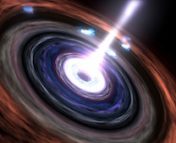Title: Discordance of dipole asymmetries seen in recent large radio surveys with the Cosmological Principle
Authors: Ashok K. Singal
First authors institution: Physical Research Laboratory, Ahmedabad, India
Status: Published in Monthly Notices of the Royal Astronomical Society [open access]
A fundamental assumption in cosmology is that the Universe is homogeneous and isotropic – which just means that on average, the distribution of galaxies looks the same to an observer placed anywhere in the Universe, and that is true looking in all directions. This assumption has largely been supported by cosmological observations of galaxies in the Universe and the Cosmic Microwave Background (CMB) radiation once our motion through the galaxy has been accounted for.
However, radio surveys of Active Galactic Nuclei (AGN) – galaxies which shine very brightly in their centre due to accreting supermassive black holes – have revealed an asymmetry in where we see these galaxies in the sky. We should expect that if we count the number of these galaxies we see in different directions, it should look pretty much the same anywhere. The only exception to this is the effects that are introduced by the motion of the solar system through the Milky Way, which creates a dipole, causing us to see fewer galaxies in the direction we are moving away from, and more in the opposite direction. This is for two main reasons. Firstly, the light from the galaxies gets red-shifted or blue-shifted (the wavelengths get stretched or squeezed respectively due to the Doppler Effect); this leads to a change in the intensity of the sources in the sky as the time between the arrival of wavefronts of light from the sources changes, leading to an altered count of photons in a detector (this is the non-relativistic form of Doppler boosting). Secondly, aberration, which refers to the apparent change in the angular position of an emitting object towards the direction of our motion and is due to the finite speed of light, further affects the number of galaxies we count in a part of the sky. The dipole that we see should have an amplitude and direction that matches up with the expected amplitude of the CMB dipole, which is also interpreted to be due to our solar system’s motion through space – this is about ∼370 km/s.
If the dipole measured from radio surveys and the CMB don’t match, this would imply that the Universe might not be homogeneous or isotropic, and would require us to reconsider this assumption or perform further tests to confirm the result. Alternatively, our interpretation of the CMB dipole could be incorrect. In previous work by the same author of today’s paper (see more about this earlier work here) it was found the dipole amplitude from radio sources to be about four times too big (compared to the CMB dipole), and other authors have found similar results. What’s more, they found even the directions of the measured dipole from the radio sources and the CMB do not exactly coincide, although they are close. However, other results have found good agreement with the CMB dipole. These conflicting results motivate today’s paper, which aims to dig deeper into whether radio surveys of AGN are consistent with the Universe being homogeneous and isotropic.
In today’s paper, the author computed the number counts of AGN using a dataset from a survey called VLASS (the Very Large Array Sky Survey) with 1.9 million sources and another called RACS (the Rapid ASKAP Continuum Survey, where ASKAP is the Australian Square Kilometre Array Pathfinder telescope) with 2.1 million sources. Using these radio sources, the author calculated the direction and the amplitude of the dipole (essentially the direction and speed of the solar system’s motion). The simplest approach uses vector addition and the dot products of vectors. If the directional vectors to the objects seen across the sky are added up, this can serve as a proxy for the direction of the dipole. To get the amplitude, the dot project of the individual direction vectors with the dipole direction can be summed together.
Alternatively, one can take two opposing directions in the sky, and calculate the excess number of galaxies in one hemisphere of the sky centred on the first direction, compared to the number of galaxies found in the other. If this is tested in lots of different pairs of directions, the pair of directions with the greatest excess of sources indicates the dipole direction, and the excess itself indicates the amplitude of the dipole. For both datasets, the author presents the apparent speed that the measured amplitude indicates for our motion relative to the speed interpreted from the CMB dipole of ~370 km/s, as well as the direction of the dipole for comparison.
The author found interesting results; the amplitude found from the VLASS data indicates the solar system is moving four times faster than what’s predicted by the CMB at 1600 ± 300 km/s. Interestingly, the RACS dataset also indicates a significant amplitude that is around eight times larger than expected at 2700 ± 300 km/s. Furthermore, for both datasets the direction of the measured dipoles differ from the CMB, and also have different directions from each other. The directions on the sky compared to the CMB from the datasets (V for VLASS, R for RACS and the for the CMB dipole) are shown in the plot below. Results from other works are also shown.

While these results might indicate we need to rethink our assumptions regarding homogeneity and isotropy or the interpretation of the CMB dipole, more work is needed to confirm if this is indeed the case. While the authors thoroughly tested the validity of their dipole measurements by applying their method to simulations of radio sources in the sky, random fluctuations in the number of galaxies in different parts of the sky or unaccounted systematics in the collected data that are not yet understood (such that it leads to biased counts of the galaxies in different parts of the sky) might lead to such results. By continuing to observe the radio sky, astronomers can further explore whether the most fundamental assumptions in cosmology could be flawed.
Edited by Sarah Bodansky and Alexandra Masegian.
Featured image credit: Figure 9 from Ashok K. Singal (2023), IRAM-gre, CC BY-SA 4.0 <https://creativecommons.org/licenses/by-sa/4.0>, via Wikimedia Commons




